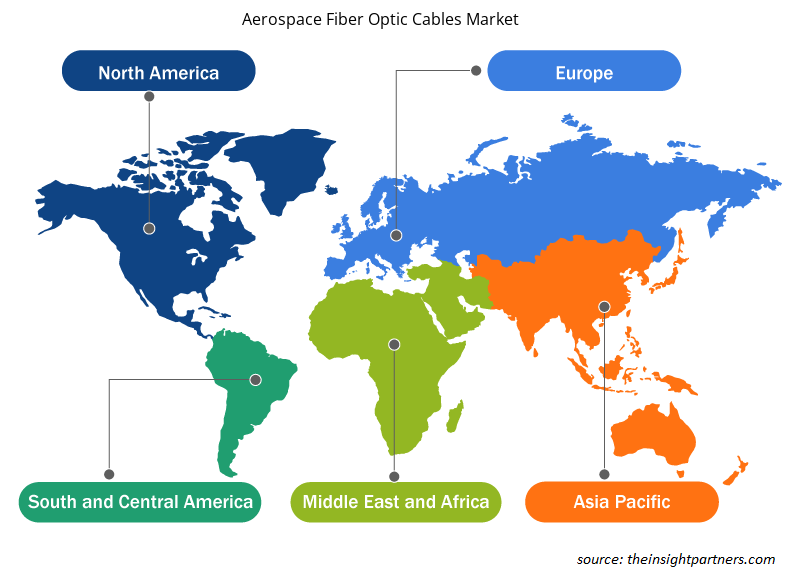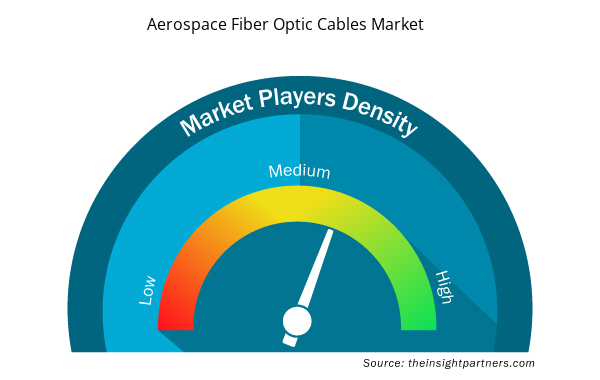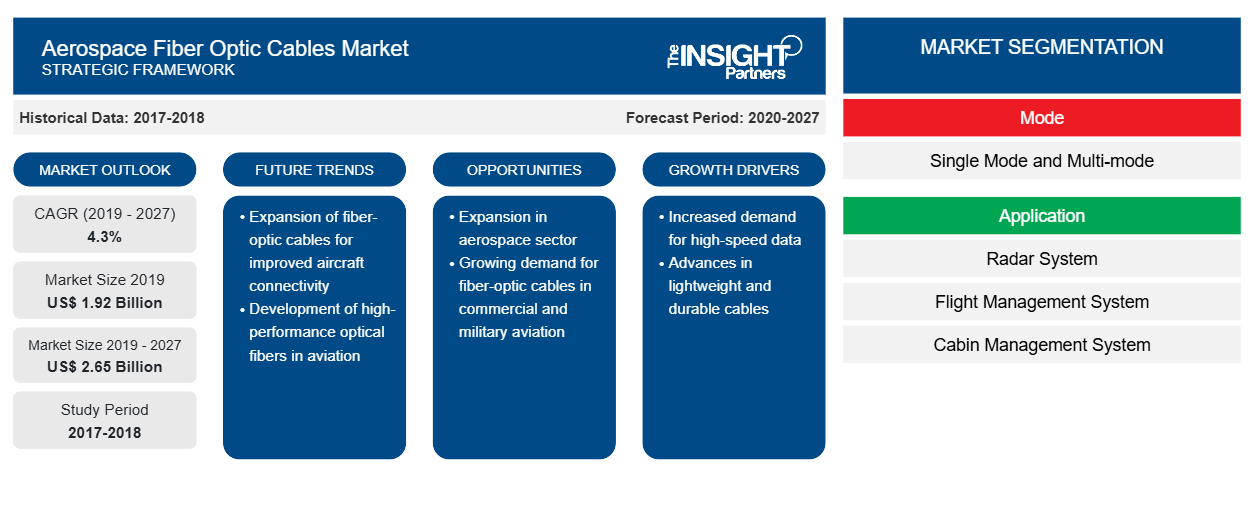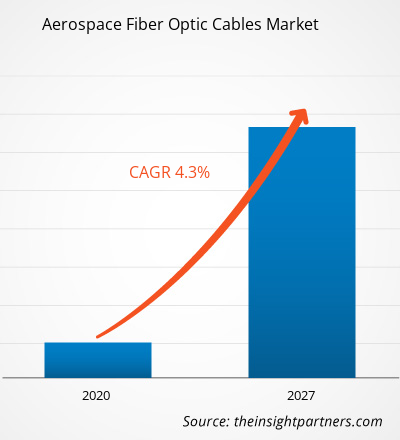就收入而言,2019 年航空航天光纤电缆市场价值为 19.2465 亿美元,预计到 2027 年将达到 26.4586 亿美元;预计预测期内复合年增长率为 4.3%。
航空航天光纤电缆市场的增长主要归功于航空航天工业对先进技术的大量投资。在过去的几十年里,航空(商业和军事)工业发展迅速;技术转型速度惊人,刺激了对各种产品和服务的需求。由于光纤电缆克服了前辈的挑战,并在军事航空业中展示了显著的优势,商业航空业对光纤电缆的需求也在增长,这推动了航空航天光纤电缆市场的增长。
从地理上看,航空航天光纤电缆市场分析基于五个战略区域,即北美、欧洲、亚太、中东和非洲以及南美。北美的航空航天业见证了大量飞机制造商、MRO 服务提供商和美国国防部的存在。该地区对先进技术的需求巨大,上述所有最终用户都非常了解新技术。美国国防部不断投入时间和资金来改进现有机队并开发强大的技术飞机,以保持一支随时准备执行任务的部队。因此,该地区几十年前就开始在军用飞机上采用光纤电缆,并且仍在继续将该技术整合到较新的军用飞机机队上。同样,该地区的商业航空航天业主要由波音公司主导,该公司还将其 B787 和 B777 型号与光纤电缆整合在一起。这种整合与驾驶舱和客舱对高速数据传输的不断增长的需求有关。 MRO 服务提供商和拥有内部 MRO 中心的航空公司已开始对旧飞机进行光纤电缆改装,这也成为北美航空航天光纤电缆市场的催化剂。该地区大量光纤电缆制造商的存在支持了不断增长的需求,从而推动了航空航天光纤电缆市场的发展。
定制此报告以满足您的需求
您可以免费定制任何报告,包括本报告的部分内容、国家级分析、Excel 数据包,以及为初创企业和大学提供优惠和折扣
- 获取此报告的关键市场趋势。这个免费样品将包括数据分析,从市场趋势到估计和预测。
COVID-19 疫情对航空航天光纤电缆市场的影响
尽管拥有机器人技术,但飞机生产行业仍然严重依赖手工劳动。随着多个国家实施严格的封锁规定,飞机制造业在各自的飞机和零部件制造工厂中都面临着劳动力短缺的问题。由于飞机制造业主要集中在北美和欧洲,这两个地区在疫情爆发后面临着保持生产速度的巨大挑战。欧洲国家生产各种飞机零部件;然而,越来越多的 COVID-19 感染患者对大多数欧洲国家构成了重大挑战。全球飞机制造商的零部件采购量急剧下降,这反映出飞机产量的下降。
由于航空航天光纤电缆市场参与者分散在北美、欧洲和亚太地区,这些地区的疫情爆发导致光纤电缆生产数量和供应链中断。这对航空航天光纤电缆市场产生了负面影响。
市场洞察
对长距离高带宽的需求不断增长,推动了航空航天光纤电缆市场的增长
近年来,由于长途航线客流量增加,商业航空公司选择长途飞行。长途飞行需要高速连接;多年来,以太网一直是商业航空公司网络基础设施协议的最佳选择,因为它具有高性能、可靠性和普遍接受的开放标准。然而,以太网网络连接在长距离传输高带宽数据方面存在局限性。由于这个原因,一些飞机布线系统制造商已经涉足光纤电缆行业,这在最近几年一直使商业航空公司受益。这对航空航天光纤电缆市场产生了积极影响。
基于模式的洞察
就模式而言,多模光纤占据了 2019 年全球航空航天光纤市场的最大份额。单模光纤一次只能散射一种光模式。但在多模光纤中,光可以散射成多种模式。单模和多模光纤之间的差异主要在于光纤芯直径、带宽、波长和光源、距离和成本。
基于应用的洞察
在应用方面,航空电子领域在 2019 年占据了全球航空航天光纤电缆市场的最大份额。航空电子应用所急需的技术进步包括抗弯曲光纤、连接器兼容性、带宽增加光纤、高密度互连、高功率激光束传输以及商用现成组件的接受度。航空电子设计师不断专注于将更多的计算能力引入嵌入式系统,这些系统能够处理导航、通信以及其他关键功能。从而减轻重量、加快数据传输速率和带宽,同时提高稳健性和安全性。
基于适合类型的洞察
根据安装类型,航空航天光缆市场分为线路安装和改造。改造在 2019 年的全球航空航天光缆市场中占据了主导地位。航空航天光缆已全面部署到新型飞机型号中,例如空客 A380 和波音 B787。航空公司正在运营其他几种较旧型号的商用飞机,由于对高带宽的需求不断增加,它们正在用光缆取代传统的铜缆。这一趋势正在获得巨大的吸引力,这得益于对更小、更轻的布线的持续需求,与传统铜线相比,这种布线提供了更高的性能。随着对高带宽飞机的需求不断增加,预计光纤在较旧的军用和商用飞机中的部署将会增加。
基于最终用户的见解
根据最终用户,航空航天光纤电缆市场分为商用和军用。2019 年,军用市场在全球航空航天光纤电缆市场中占据主导地位。光纤网络和电缆组件供应商正在协助军用飞机设计师满足他们对新能力和改进性能的不断需求,以保持对潜在敌人的改进。这些光纤网络正逐渐变得更加先进,以支持新一代先进视觉系统、航空电子设备和其他新兴技术。
全球航空航天光纤电缆市场中大量知名企业和新兴公司的存在,支撑着终端用户不断增长的需求。向飞机制造商、飞机部件制造商和改装终端用户持续供应光纤电缆,在航空航天光纤电缆市场的成熟中发挥着至关重要的作用。以下列出了航空航天光纤电缆市场最近的一些收购:
2019 年:安费诺航空航天公司 (Amphenol Aerospace) 与 Samtec 合作设计和开发新型 Centaur 高速电缆组件,该组件利用安费诺广泛的军用规格连接器产品组合和最新的高速接触件和连接器技术以及 Samtec 的 ExaMAX 高速背板系统的优势,提供耐用、经过全面测试的高带宽连接,非常适合用于航空航天、军事和其他加固应用。2018
年:WL Gore & Associates UK Ltd. 推出加固型 1.8 毫米单工航空航天光纤电缆,用于在军用高速航空电子网络上以每秒 10 千兆位的速度传输关键任务数据。
航空航天光纤电缆市场区域洞察
Insight Partners 的分析师已详尽解释了预测期内影响航空航天光纤电缆市场的区域趋势和因素。本节还讨论了北美、欧洲、亚太地区、中东和非洲以及南美和中美洲的航空航天光纤电缆市场细分和地理位置。

- 获取航空航天光纤电缆市场的区域特定数据
航空航天光纤电缆市场报告范围
| 报告属性 | 细节 |
|---|---|
| 2019 年市场规模 | 19.2亿美元 |
| 2027 年市场规模 | 26.5亿美元 |
| 全球复合年增长率(2019 - 2027) | 4.3% |
| 史料 | 2017-2018 |
| 预测期 | 2020-2027 |
| 涵盖的领域 | 按模式
|
| 覆盖地区和国家 | 北美
|
| 市场领导者和主要公司简介 |
|
市场参与者密度:了解其对商业动态的影响
航空航天光纤电缆市场正在快速增长,这得益于终端用户需求的不断增长,而这些需求又源于消费者偏好的不断变化、技术进步以及对产品优势的认识不断提高等因素。随着需求的增加,企业正在扩大其产品范围,进行创新以满足消费者的需求,并利用新兴趋势,从而进一步推动市场增长。
市场参与者密度是指在特定市场或行业内运营的企业或公司的分布情况。它表明在给定市场空间中,相对于其规模或总市场价值,有多少竞争对手(市场参与者)存在。
在航空航天光纤电缆市场运营的主要公司有:
- 安费诺航空航天
- 澳式足球联盟
- 卡莱尔互联技术公司
- 柯林斯航空(雷神技术公司)
- 耐克森
免责声明:上面列出的公司没有按照任何特定顺序排列。

- 了解航空航天光纤电缆市场的主要参与者概况
市场细分
航空航天光纤电缆市场 – 按模式划分
- 单模
- 多模式
航空航天光纤电缆市场 – 按应用划分
- 雷达系统
- 飞行管理系统
- 客舱管理系统
- 机上娱乐系统
- 电子战
- 航空电子设备
- 其他的
航空航天光纤电缆市场 – 按类型划分
- 线拟合
- 改造
航空航天光纤电缆市场 – 按最终用户划分
- 商业的
- 军队
航空航天光纤电缆市场(按区域)
北美
- 我们
- 加拿大
- 墨西哥
欧洲
- 法国
- 德国
- 意大利
- 英国
- 俄罗斯
- 欧洲其他地区
亚太地区 (APAC)
- 中国
- 印度
- 韩国
- 日本
- 澳大利亚
- 亚太地区其他地区
中东和非洲 (MEA)
- 南非
- 沙特阿拉伯
- 阿联酋
- MEA 其他地区
南美洲 (SAM)
- 巴西
- 阿根廷
- SAM 其余部分
航空航天光纤电缆市场公司简介如下:
- 安费诺公司
- 澳式足球联盟
- 卡莱尔互联技术公司
- 柯林斯航空(雷神技术公司)
- 耐克森公司
- 戈尔公司
- Timbercon 公司
- TE Connectivity
- 普睿司曼集团
- OFS Fitel 有限责任公司
- 历史分析(2 年)、基准年、预测(7 年)及复合年增长率
- PEST 和 SWOT 分析
- 市场规模价值/数量 - 全球、区域、国家
- 行业和竞争格局
- Excel 数据集



Report Coverage
Revenue forecast, Company Analysis, Industry landscape, Growth factors, and Trends

Segment Covered
This text is related
to segments covered.

Regional Scope
North America, Europe, Asia Pacific, Middle East & Africa, South & Central America

Country Scope
This text is related
to country scope.
常见问题
The avionics segment led the aerospace fiber optic cables market. Some of the most important applications for fiber optics in avionics are sensing, remote communications, the combination of several information systems, as well as IR countermeasure devices to safeguard aircraft from IR homing missiles. Additionally, avionics designers are focused continuously on outing more computing power into embedded systems, which are capable of handling navigation, communications, as well as other critical functions.
The aerospace industry in North America is matured with the existence of a large number of aircraft manufacturers, MRO service providers, and US DoD. The demand for advanced technologies is tremendous in the region, with all the end users mentioned above are well aware of newer technologies. The US DoD continuously invests time and amounts towards the advancements of existing fleet and development of robust technology aircraft with an objective to maintain a mission-ready force. Additionally, the presence of a large number of fiber optic cable manufacturers in the region is supporting the ever-rising demand, which is thereby boosting the aerospace fiber optic cables market
The aircraft manufacturers are heavily challenged on decreasing the overall weight of any aircraft. This is due to the fact that weight is a significant enemy to the aerospace industry. Pertaining to this, the airframe manufacturers and component manufacturers are continuously seeking upgraded technologies that are lighter in weight. As a majority of commercial aircraft end users/owners are increasingly seeking fuel-efficient aircraft for better performance on long-haul flights, the demand for weight reduction continues to surge among the airframe manufacturers. On the other hand, the military aircraft owners are seeking lightweight aircraft in order to operate the planes easily on any mission. Pertaining to this, the demand for composite-based components, lightweight wiring, and cabling systems is on the rise, which is generating revenue generation stream in the aerospace fiber optic cables market.
Trends and growth analysis reports related to Aerospace and Defense : READ MORE..
The List of Companies - Aerospace Fiber Optic Cables Market
- Amphenol Aerospace
- AFL
- Carlisle Interconnect Technologies
- Collins Aerospace, a Raytheon Technologies Company
- Nexans
- OFS Fitel, LLC
- Prysmian Group
- TE Connectivity
- Timbercon, Inc.
- W. L. Gore & Associates, Inc.
The Insight Partners performs research in 4 major stages: Data Collection & Secondary Research, Primary Research, Data Analysis and Data Triangulation & Final Review.
- Data Collection and Secondary Research:
As a market research and consulting firm operating from a decade, we have published and advised several client across the globe. First step for any study will start with an assessment of currently available data and insights from existing reports. Further, historical and current market information is collected from Investor Presentations, Annual Reports, SEC Filings, etc., and other information related to company’s performance and market positioning are gathered from Paid Databases (Factiva, Hoovers, and Reuters) and various other publications available in public domain.
Several associations trade associates, technical forums, institutes, societies and organization are accessed to gain technical as well as market related insights through their publications such as research papers, blogs and press releases related to the studies are referred to get cues about the market. Further, white papers, journals, magazines, and other news articles published in last 3 years are scrutinized and analyzed to understand the current market trends.
- Primary Research:
The primarily interview analysis comprise of data obtained from industry participants interview and answers to survey questions gathered by in-house primary team.
For primary research, interviews are conducted with industry experts/CEOs/Marketing Managers/VPs/Subject Matter Experts from both demand and supply side to get a 360-degree view of the market. The primary team conducts several interviews based on the complexity of the markets to understand the various market trends and dynamics which makes research more credible and precise.
A typical research interview fulfils the following functions:
- Provides first-hand information on the market size, market trends, growth trends, competitive landscape, and outlook
- Validates and strengthens in-house secondary research findings
- Develops the analysis team’s expertise and market understanding
Primary research involves email interactions and telephone interviews for each market, category, segment, and sub-segment across geographies. The participants who typically take part in such a process include, but are not limited to:
- Industry participants: VPs, business development managers, market intelligence managers and national sales managers
- Outside experts: Valuation experts, research analysts and key opinion leaders specializing in the electronics and semiconductor industry.
Below is the breakup of our primary respondents by company, designation, and region:

Once we receive the confirmation from primary research sources or primary respondents, we finalize the base year market estimation and forecast the data as per the macroeconomic and microeconomic factors assessed during data collection.
- Data Analysis:
Once data is validated through both secondary as well as primary respondents, we finalize the market estimations by hypothesis formulation and factor analysis at regional and country level.
- Macro-Economic Factor Analysis:
We analyse macroeconomic indicators such the gross domestic product (GDP), increase in the demand for goods and services across industries, technological advancement, regional economic growth, governmental policies, the influence of COVID-19, PEST analysis, and other aspects. This analysis aids in setting benchmarks for various nations/regions and approximating market splits. Additionally, the general trend of the aforementioned components aid in determining the market's development possibilities.
- Country Level Data:
Various factors that are especially aligned to the country are taken into account to determine the market size for a certain area and country, including the presence of vendors, such as headquarters and offices, the country's GDP, demand patterns, and industry growth. To comprehend the market dynamics for the nation, a number of growth variables, inhibitors, application areas, and current market trends are researched. The aforementioned elements aid in determining the country's overall market's growth potential.
- Company Profile:
The “Table of Contents” is formulated by listing and analyzing more than 25 - 30 companies operating in the market ecosystem across geographies. However, we profile only 10 companies as a standard practice in our syndicate reports. These 10 companies comprise leading, emerging, and regional players. Nonetheless, our analysis is not restricted to the 10 listed companies, we also analyze other companies present in the market to develop a holistic view and understand the prevailing trends. The “Company Profiles” section in the report covers key facts, business description, products & services, financial information, SWOT analysis, and key developments. The financial information presented is extracted from the annual reports and official documents of the publicly listed companies. Upon collecting the information for the sections of respective companies, we verify them via various primary sources and then compile the data in respective company profiles. The company level information helps us in deriving the base number as well as in forecasting the market size.
- Developing Base Number:
Aggregation of sales statistics (2020-2022) and macro-economic factor, and other secondary and primary research insights are utilized to arrive at base number and related market shares for 2022. The data gaps are identified in this step and relevant market data is analyzed, collected from paid primary interviews or databases. On finalizing the base year market size, forecasts are developed on the basis of macro-economic, industry and market growth factors and company level analysis.
- Data Triangulation and Final Review:
The market findings and base year market size calculations are validated from supply as well as demand side. Demand side validations are based on macro-economic factor analysis and benchmarks for respective regions and countries. In case of supply side validations, revenues of major companies are estimated (in case not available) based on industry benchmark, approximate number of employees, product portfolio, and primary interviews revenues are gathered. Further revenue from target product/service segment is assessed to avoid overshooting of market statistics. In case of heavy deviations between supply and demand side values, all thes steps are repeated to achieve synchronization.
We follow an iterative model, wherein we share our research findings with Subject Matter Experts (SME’s) and Key Opinion Leaders (KOLs) until consensus view of the market is not formulated – this model negates any drastic deviation in the opinions of experts. Only validated and universally acceptable research findings are quoted in our reports.
We have important check points that we use to validate our research findings – which we call – data triangulation, where we validate the information, we generate from secondary sources with primary interviews and then we re-validate with our internal data bases and Subject matter experts. This comprehensive model enables us to deliver high quality, reliable data in shortest possible time.


 获取此报告的免费样本
获取此报告的免费样本